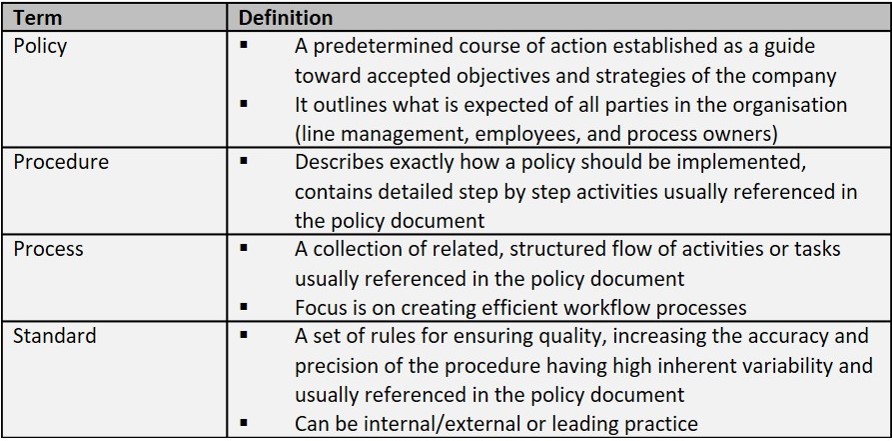If you’re searching the internet for the tips on how to write a corporate or business policy, what you would find is mostly guides on a format, definitions of terms ,and some style tips. These types of guides, however useful in theory, don’t address all the fundamental aspects of policy writing; especially if you are new to the “policy writing business”.
In a nutshell, policies are created to help companies and their staff
distinguish between what’s right and what’s wrong in the business. They should
serve as a guide to people in making the right decisions and being aware of
what’s considered wrongful behaviour/ process and what is the desired behaviour
or handling of a process. Articulating this correctly helps people better
understand how they are expected to proceed. Policy is the principle(s) a
company desires, and the “how to” are the procedures and processes of enacting
said policy. Ensuring a sound and articulate policy is put in place allows for
better communication between the business and its people.
Policies, procedures, processes, and standards should have at their core the
intention to be instrumental to the day-to-day operations and management of an
organisation. Policies should be developed in light of the mission and
objectives of an organisation, and they become the media through which
management plans, intentions, documents, and communicates its business
principles.
Although every company has their own way of addressing those elements, the
basic principles of writing policies are common across all industries and types
of business. Writing sound policies with the right process embedded in them is
critical to executing positive business relationships and protecting the
business interests.
Based on my experience, the top 10 tips for writing policies are:
1.
Start with the policy framework
The policy framework informs employees and policy owners about the fundamental
stance in policy writing in line with the company’s organisational culture. A
sound policy framework is essential for (1) effective and efficient governance,
and (2) providing a foundation for appropriate business decision-making and
directing the operations of the company. It is through the evaluation of our
adherence to policy that we hold ourselves accountable and are held accountable
by others.
2.
Review existing basket of policies
A review of existing policies should precede any attempt at developing new
policies to ensure that the objective of the new policy is not already
adequately addressed elsewhere in existing policies and related references.
3.
Determine the tone
The tone of a policy informs employees about the principles on which policy
development is based. Is it fun or serious? Is it holistic or all business?
Policies are expressive of the culture of an organisation and therefore style
and tone, as well as enforcement approach, combine to reflect the culture of the
organisation. Additionally, the policy owner’s fundamental stance in policy
writing shouldn’t be the one of distrust, but rather of confidence in the
integrity of those who will be directed by the policy.
4.
Define the policy holders
The custodian and a single repository for all policies must be defined up front
and must be easy to find. The custodian is responsible for establishing,
implementing, and maintaining a central policy repository for all editable,
soft-copy policy versions and keeping un-editable scanned versions in the
company repository.
5.
Distinguish between the terms
It is very important to make a clear distinction between policy, procedure,
process and standard:

6. Keep it short and sweet
A policy shouldn’t be longer than five pages. Procedures, processes, and
standards can be shown in the same document but only as annexures to keep a
policy’s principles clear and easy to understand.
7.
Use the right format
The policy format must be very prescriptive in terms of what the format of all
policies should look like and what components are necessary (For example the
document header on the first page must record a company logo which can be
right-aligned, have the title of the policy in the middle of the page, and
policy details can be left aligned, etc.)
8.
Establish the policy groundwork
Basic policies that underpin all the other policies must be in place before any
other policy is defined (e.g. Disciplinary code, delegation of authority, code
of ethics).
9.
Confirm the impact
Policy impact on external stakeholders, in a form of a statement of intent,
should be part of a policy. This statement should be sent to external
stakeholders when needed (e.g. gift policy statement) instead of sharing the
whole of the company’s policies to external parties.
10.
Remember compliance
Policy compliance is not an abstract concept. Clear compliance procedures
encourage all employees to act with integrity, in line with company’s values
and culture operating system, and within the framework of the policy and related
processes, procedures and standards. Through policy compliance, the company can
preserve the legitimate interests of all stakeholders.
If you’re currently writing a policy, have you used all ten of the above steps?
If not, you’ll risk leaving money, stakeholder relationship, and performance to
chance. If you begin using these steps, you’re already on the right track to
improve your company’s bottom line and contributing to healthy external and
internal relationships.
Contributed by: Mira Ristovich, a Senior Associate at Bespoke Group Africa, with 30 years’ experience as an economist as well as exceptional procurement and business acumen
Article first appeared in: 